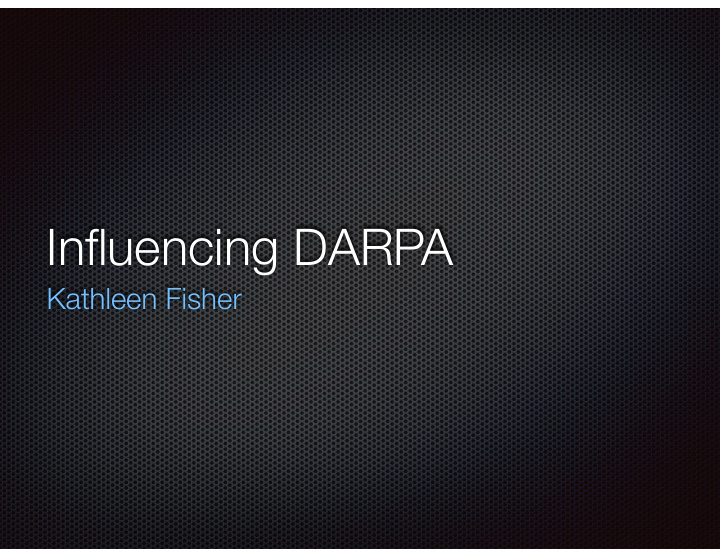



Influencing DARPA Kathleen Fisher
DARPA’s Mission Assure that the US leads the world in technology for national defense Avoid/create “Sputnik surprises” Build communities of “change- “Creating breakthrough technologies state advocates” for national security” Define challenges, develop solution concepts, demonstrate them. Take “technical risk” off the table
DARPA’s structure DARPA (DIRO) - $2.9B Information Biological Microsystems Technologies Office Innovation O ffi ce Technologies Office (BTO) (MTO) (I2O) - $540M Defense Sciences Tactical Strategic Office Technologies Office Technologies Office (DSO) (TTO) (STO)
Where do DARPA Programs Come From? Program manager has an idea. Many sources: Original motivation for joining DARPA Emerges from existing program or seedling Emerges from an ISAT Workshop or discussions at DARPA Suggestions from members of the community. Program manager refines the idea. Many sources of input: Potential performers and members of the technical community Office Director, Deputy Director, and other Program Managers SETA Staff Technical papers and policy documents
The Pitch Hour-long presentation and Q&A to DARPA’s Tech Council Questions that must be addressed: What is the problem that needs to be solved? Why DARPA? How is the problem currently addressed and why is that insufficient? What is the possible new technology/approach? Why does it have a chance of succeeding? How will the program be structured? How will progress be measured? What resources will be needed?
The BAA (Broad Agency Announcement) Program Manager (PM) drafts the BAA, which describes program vision, the requirements for each technical area, and the evaluation criteria. Once the BAA is published, the PM is constrained in talking to potential performers: can only discuss publicly available information. (But, can add things to the public FAQ as necessary). Questions can be sent to BAA mailing list; answers are posted to the FAQ. Proposals that don’t follow the requirements described in the BAA can/will be summarily rejected before it gets to the PM .
Proposer’s Day Opportunity to: Hear PM talk about the program Ask a question or two Hear answers to other people’s questions Meet other interested parties
Proposal Review at DARPA Selection committee of government employees. PM ensures each proposal receives three substantive reviews that address each review criterion from the BAA. Technical Merit: What are the key technical ideas? To what extent are they plausible and relevant? What are the qualifications of the key personnel? To what extent are the Schedule and SOW logical and feasible? To what extent is the Management Plan appropriate? Does the proposal identify and offer appropriate mitigations for both technical and programmatic risk? Relevance to DARPA: To what extent does the proposed work address problems relevant to DARPA? Would IP issues prevent the DoD from using the developed technology? Cost Volume Are the costs reasonable for the proposed work? What is the basis of confidence for the cost estimates?
How are DARPA programs managed/evaluated? In the Spring, each PM meets with Office Leadership to summarize program results. In the Fall, each PM makes a presentation to DARPA leadership to summarize program results. If not making progress, a program can be scaled back or cut entirely. Management is reasonable; Expect some things to go worse than expected and others to go better. Looking for signs that the program hypothesis is or is not achievable. When PM evaluates proposals, s/he is looking to put together a portfolio of performers who maximize the chance of the overall program succeeding .
Opportunities for Engagement
Serve as a Program Manager DARPA is always hiring ~25% turnover each year All PMs and Office Directors are on term appointments two to six year rotations from government, industry, and academia people whose “hair is on fire” to work on a particular problem relevant to national security It’s like running a lab staffed with ten of the best research groups in the world as your graduate students.
ISAT Information Science and Technology Study Group Mission : Alert DARPA to areas of potential technological surprise the Agency may not be aware of and suggest opportunistic directions for research in information technology Members serve 3 year terms (by invitation only) 30 thought leaders from industry and academia 3 meetings a year Run 8-10 ideation workshops/year with 15-35 external experts; report conclusions to DARPA
Talk to Program Managers* Everybody gets 30 minutes Go in person Do your homework: know their background and their current programs (if any) Plan for a technical dialogue: be prepared to have a discussion about the most urgent/exciting tech opportunities. Don’t do a hard sell on your research. Position yourself as a resource *Particularly when they are working on creating a new program.
Seedlings PMs often have money for seedlings: focused studies that either support an area of technical risk in a current program or explore new program ideas . Scale: 1-2 year period of performance, <$1M Often start with technical conversation with PM Opportunity to influence creation of a new program
Questions?
Recommend
More recommend